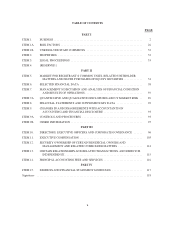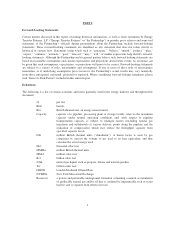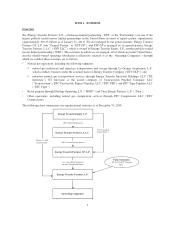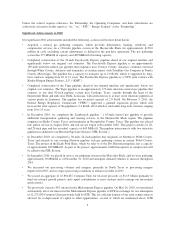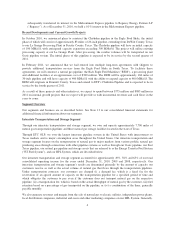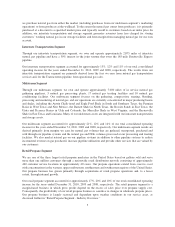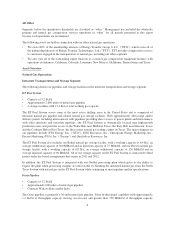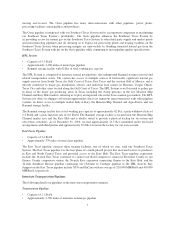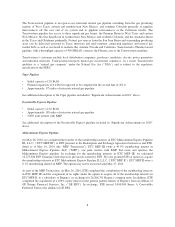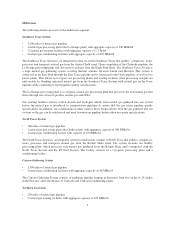Energy Transfer 2010 Annual Report Download - page 7
Download and view the complete annual report
Please find page 7 of the 2010 Energy Transfer annual report below. You can navigate through the pages in the report by either clicking on the pages listed below, or by using the keyword search tool below to find specific information within the annual report.we purchase natural gas from either the market (including purchases from our midstream segment’s marketing
operations) or from producers at the wellhead. To the extent the natural gas comes from producers, it is primarily
purchased at a discount to a specified market price and typically resold to customers based on an index price. In
addition, our intrastate transportation and storage segment generates revenues from fees charged for storing
customers’ working natural gas in our storage facilities and from margin from managing natural gas for our own
account.
Interstate Transportation Segment
Through our interstate transportation segment, we own and operate approximately 2,875 miles of interstate
natural gas pipeline and have a 50% interest in the joint venture that owns the 185-mile Fayetteville Express
pipeline.
Our interstate transportation segment accounted for approximately 13%, 12% and 11% of our total consolidated
operating income for the years ended December 31, 2010, 2009 and 2008, respectively. The results from our
interstate transportation segment are primarily derived from the fees we earn from natural gas transportation
services and, for the Transwestern pipeline, from operational gas sales.
Midstream Segment
Through our midstream segment, we own and operate approximately 7,000 miles of in service natural gas
gathering pipelines, 3 natural gas processing plants, 17 natural gas treating facilities and 10 natural gas
conditioning facilities. Our midstream segment focuses on the gathering, compression, treating, blending,
processing and marketing of natural gas, and our operations are currently concentrated in major producing basins
and shales, including the Austin Chalk trend and Eagle Ford Shale in South and Southeast Texas, the Permian
Basin in West Texas and New Mexico, the Barnett Shale in North Texas, the Bossier Sands in East Texas, the
Uinta and Piceance Basins in Utah and Colorado, the Marcellus Shale in West Virginia, and the Haynesville
Shale in East Texas and Louisiana. Many of our midstream assets are integrated with our intrastate transportation
and storage assets.
Our midstream segment accounted for approximately 21%, 12% and 14% of our total consolidated operating
income for the years ended December 31, 2010, 2009 and 2008, respectively. Our midstream segment results are
derived primarily from margins we earn for natural gas volumes that are gathered, transported, purchased and
sold through our pipeline systems and the natural gas and NGL volumes processed at our processing and treating
facilities. We also market natural gas on our pipeline systems in addition to other pipeline systems to realize
incremental revenue on gas purchased, increase pipeline utilization and provide other services that are valued by
our customers.
Retail Propane Segment
We are one of the three largest retail propane marketers in the United States based on gallons sold and serve
more than one million customers through a nationwide retail distribution network consisting of approximately
440 customer service locations in approximately 40 states. Our propane operations extend from coast to coast
with concentrations in the western, upper midwestern, northeastern and southeastern regions of the United States.
Our propane business has grown primarily through acquisitions of retail propane operations and, to a lesser
extent, through internal growth.
Our retail propane segment accounted for approximately 17%, 20% and 10% of our total consolidated operating
income for the years ended December 31, 2010, 2009 and 2008, respectively. The retail propane segment is a
margin-based business in which gross profits depend on the excess of sales price over propane supply cost.
Consequently, the profitability of our retail propane business is sensitive to changes in wholesale propane prices.
Our propane business is largely seasonal and dependent upon weather conditions in our service areas, as
discussed further in “Retail Propane Segment - Industry Overview.”
5


